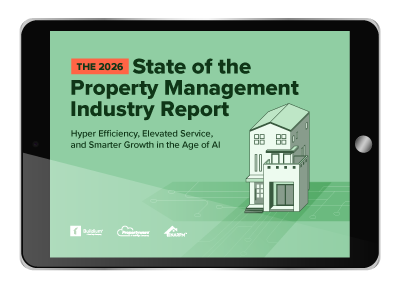More and more property managers are finding their clientele shifting from accidental landlords to strategically minded rental real estate investors. And they’re relying on the property management companies they hire to help them make the most of their investments.
They’re looking for property managers with a deep knowledge of their market, the most effective investment strategies, and the tax and compliance laws they need to follow. That includes a knowledge of 1031 exchange rules.
Established real estate investors and property managers are likely already familiar with 1031 exchanges. But if you’re unfamiliar with this tax deferment strategy, or you need to brush up on your 1031 exchange rules, this post can walk you through it.
What Is a 1031 Exchange?
The concept of a 1031 exchange is relatively simple: Reinvest the proceeds from the sale of a business or investment property into a like-kind investment in order to defer paying capital gains tax for you or your owners. It’s one of the most popular sections in the Federal tax code because it allows owners of rental property to save big.
What Is the Benefit of a 1031 Exchange?
With a section 1031 exchange, also called a like-kind exchange, again, you can defer paying taxes upon the sale of property by swapping your property for similar property owned by someone else. The property you receive in a like-kind exchange is treated as if it were a continuation of the property you gave up. The result is that you postpone the recognition (taxation) of gain by shifting the basis of old property to the new property. So, you defer paying taxes on any profit you would have received and own new property instead.
What Are the 1031 Exchange Requirements for Property?
You can use tax-free exchanges for investment and business real property, but not your personal residence or your personal property (your car, for example). Real property is defined as a parcel of land and everything permanently attached to it, such as buildings. As a result, landlords can use a 1031 exchange for their rental real estate and businesses can use it for office buildings and other business property.
What Does “Like-Kind” Mean?
You may only exchange property for other similar property, called like-kind property by the IRS. Like-kind properties have the same nature or character, even if they differ in grade or quality. All real estate owned for investment or business use in the United States is considered to be like-kind with all other such real estate in the United States, no matter the type or location. For example, an apartment building in New York is “like-kind” to an office building in California.
1031 Exchange Basic Calculations
To get a better idea of how to conduct a 1031 tax exchange, let’s walk through an example.
Let’s say you bought a single-family rental property some years ago for $300,000. Today, it’s worth $500,000, and you decide it’s time to sell. Rather than paying capital gains on the $200,000 the house has appreciated, you could use a 1031 exchange to reinvest the proceeds from the sale of the single-family property into another rental property and defer the tax payment.
If you keep exchanging your property for property worth at least as much as yours, you’ll never recognize any gain on which you must pay tax. However, sooner or later you’ll probably want to sell the replacement property for cash, not exchange it for another property. When that occurs, the original deferred gain, plus any additional gain realized since the purchase of the replacement property, is subject to tax. For that reason, a like-kind exchange is tax deferred, not tax free.
Assume that five years after the exchange described in the above example, you sell your rental property for $800,000 cash. Now you have to pay tax—and quite a lot at that—because you have a $500,000 long-term capital gain. Your gain is $500,000 because your basis in the property is only $300,000 (the basis of the property you exchanged for the building five years earlier). The $800,000 sales price minus the $300,000 basis = $500,000 gain.
Seems simple enough, right? Well, in reality, 1031 exchanges are much more complex. Section 1031 of the Internal Revenue Code has many nuances that can be off-putting for first-timers. There are very specific guidelines governing the process. Here’s a brief overview of what you need to know about a typical 1031 exchange process.
The 3 Types of 1031 Exchanges
There are three methods you can use to make a like-kind exchange. Let’s take a look at each of them.
#1: Deferred or Delayed 1031 Exchange (The 45-Day Rule and the 180-Day Rule)
This is the most common type of 1031 exchange. But be warned, there is a timeline for this type of 1031 exchange. In this case, the investor closes on the relinquished property; then, within 45 days (the “identification period”), they identify a replacement property. For a replacement property to be considered valid, one of three criteria must be true:
Three Property Rule: An investor identifies up to three different properties as potential purchases within the 45-day identification period, regardless of the total fair market value of the properties.
200% Rule: An investor may identify an unlimited number of replacement properties, as long as the total fair market value of all properties does not exceed 200% of the value of the relinquished property.
95% Rule: An investor may identify as many exchange properties as they want, as long as they receive at least 95% of the value of all identified replacement properties before the end of the exchange period.
In addition to the 45-day identification period, an investor only has 180 days from when they close on the relinquished property to close on the replacement property (the “exchange period”). These two dates are critical for investors to remember.
It’s important to remember that these two rules run concurrently. When you close on a property, you have 45 days to designate a replacement property and then another 135 days to close on your replacement.
Pro Tip: Because of these time limits, it’s a good idea to have a replacement property lined up before you sell your property. Professional exchange companies (also called accommodators or facilitators) can help you find replacement property and handle the transaction for you.
Finally, this type of 1031 exchange requires investors to use a Qualified Intermediary (QI), also known as an “accommodator.” A QI is an uninvolved third party who holds the investor’s sales proceeds from the sale of their relinquished property in an escrow account until they close on the replacement property. If an investor were to touch the sales proceeds before closing on the replacement property, they would be in violation of Section 1031 and could be held liable for the taxes owed on those proceeds.
Example: You own a rental triplex you bought for $400,000 that is now worth $500,000. You want to exchange it for other property instead of selling it and paying taxes on the $100,000 profit. You a qualified intermediary. The QI locates a small apartment building worth $500,000 that you like. The owner of the building, however, has no interest in exchanging it for other property. You and the QI enter into an exchange agreement. The QI purchases the building for $500,000 cash that she borrows and then exchanges it for your triplex. The QI receives a fee for facilitating the exchange and sells your triplex to repay the funds she borrowed to buy the property. With the QI’s help, you have exchanged your triplex for the apartment building, even though the owner didn’t want to do an exchange.
#2: Simultaneous 1031 Exchange
The investor closes on the relinquished property, then closes on the replacement property immediately thereafter—usually within one day. An investor may use a QI to handle the funds, but they’re not required to.
#3: Reverse 1031 Exchange
The investor acquires a replacement property before conveying the relinquished property to the new buyer. In this case, the 45-Day Rule and the 180-Day rule still apply, and you must transfer the new property to an exchange accommodation title holder. Once you have sold your original property, you must identify the replacement property within 45 days and finish transferring it back to you in 180 days.
Still with us? Great! Because we aren’t done just yet.
1031 Exchanges Rules to Keep in Mind
If you’re considering a 1031 exchange, keep in mind that there are rules you must follow. To get a full understanding of a like-kind exchange, be sure to consult a tax or legal professional.
Properties Must Be Purchased by the Same Party
Okay, this gets a little confusing, because you are using intermediaries to hold on to cash or even your replacement property for a certain time period. And that’s just the thing, the use of an intermediary is temporary. The buyer and seller on both of the closing docs, however, must be the same party.
Replacement Property Must Be of Equal or Greater Value
As a general rule, investors should remember that the replacement property must be of equal or greater value (net of closing costs) than the relinquished property, and all exchange equity must be reinvested for the full tax deferral. To put it simply: trade up and get no cash out.
You Must File Form 8824 with the IRS
You must file form 8824 for every 1031 exchange you complete within a given year. This form declares your like-kind exchange to the IRS and indicates the tax deferral.
You Must Pay Taxes on the Boot
In some instances, a 1031 exchange includes the transfer of property that is not considered a like-kind exchange. For example, the sale might include a cash payment to be used toward capital upgrades at the replacement property, which is called a boot. Because the cash is not considered like-kind property, the investor may be responsible for paying taxes on the boot portion of the exchange.
Meanwhile, a mortgage boot is when an investor reduces the mortgage liability on the replacement property below the mortgage liability on their relinquished property. Remember, the replacement property’s debt must be equal to or greater than the sold property’s debt. When a mortgage boot is present, an investor may have to add fresh cash to the transaction to offset the difference.
1031 Exchange: The Bullet Points
All that information is probably a bit overwhelming. Let’s break down the key takeaways of a 1031 exchange:
1. Identify the Property You’re Selling: Remember, it can’t be a private residence. It must be a real property used for business purposes.
2. Find a Qualified Intermediary: This is an important step you should take before you list and sell your property. That way, they are ready to take possession of the money as soon as you sell it.
3. Identify a Replacement Property: Don’t forget that this property must be equal to or greater than the value of the property you’re selling.
4. Sell and Buy Your Properties: Once you sell your property, you have 45 days to identify your replacement property. At the same time, you have 180 days to complete your purchase, including the transfer of funds from the QI.
5. File form 8824 with the IRS: When you do your taxes, this is the form you will need to submit to notify the IRS of your 1031 exchange.
There are countless situations in which a 1031 exchange might be a tax-efficient strategy to preserve your capital. If you’re thinking about using a 1031 exchange, we suggest contacting your tax advisor to discuss the transaction in greater detail.
Read more on Accounting & Reporting

